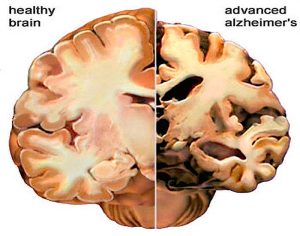Melanoma risk between persons with high and low vitamin D levels
Melanoma Risk By Marc Sorenson, EdD, Sunlight Institute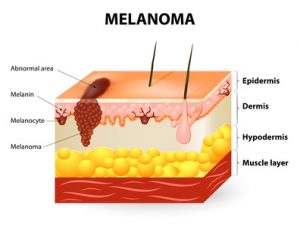
The risk directly associates with low levels of vitamin D. That is the conclusion of recent study published in the European Journal of Cancer.[1] The investigators measured the blood vitamin D levels of 137 subjects who had been diagnosed with melanoma. They collected the blood samples at the time of diagnosis of the disease. Another group of 99 healthy subjects served as the control group. The investigators collected the samples of the control group between October and April. The scientists then compared the blood collections of the melanoma group with those of the control group. They then determined whether vitamin D levels had an association with melanoma risk.
The study produced convincing results regarding vitamin D and melanoma risk.
The results were as follows:
- The controls (no melanoma) had vitamin D levels 50% higher than the melanoma group (27.8 ng/ml vs. 18 ng/ml).
- 66.2% of the melanoma group had vitamin D “deficiency,” compared to only 15.2% of the health controls. The scientists defined vitamin D deficiency as being equal to or less than 20 ng/ml. So, the melanoma group had more than four-times the risk of deficiency.
- The scientists defined vitamin D “sufficiency” as being equal to or greater than 30 ng/ml. They found that only 7.4% of melanoma patients were sufficient, compared to 37.4% of healthy controls. Hence, the melanoma group had about one-fifth the likelihood of having sufficient D levels.
More scientific analysis on vitamin D measurements vs. melanoma risk
The scientists then adjusted the data for possible confounding factors such as age, sex and body mass. Then, they performed an analysis that showed the following:
- First of all, the science demonstrated a significant inverse association with vitamin D sufficiency versus deficiency. Those who had sufficient levels had only 4% of the melanoma risk when compared to those who were deficient! Hence, this demonstrates that those with the lowest vitamin D levels (after adjusting for confounding factors) had 25-times the melanoma risk!
- And, vitamin D insufficiency vs. deficiency was significantly inversely associated with melanoma. Those who were insufficient had a definite advantage over those who were deficient. They had only 13% of the melanoma risk.
Now, this is the most important point about melanoma risk:
In addition, this research proves conclusively that sun deprivation is a major cause of melanoma. I say this because about 90% of serum vitamin D is produced by sun exposure to the skin.[2] So, the aforementioned research is really research on sun exposure. It shows that regular sun exposure leads to a profound reduction in melanoma risk. Therefore, Vitamin D levels are surrogate measurements for sun exposure in nearly every case.
Could sunlight increase health through photoproducts beyond vitamin D?
In conclusion: My new book, Embrace the Sun (coauthored by Dr. William Grant), notes that sun exposure provides more than vitamin D. It also provides other photoproducts such as nitric oxide, serotonin, endorphin, and brain-derived neurotropic factor (BDNF). All of these photoproducts are vital to human health. Could these photoproducts have a positive and protective effect against melanoma risk beyond vitamin D? And, vitamin D produced by sunlight may be superior to that given in pill form.
Finally, this research gives us one more reason to embrace the sun safely without burning. And who would have thought that safe sunlight could be one of the best prophylactics against melanoma risk?
Happy sunning!
The book is available at Amazon: https://www.amazon.com/Embrace-Sun-Marc-B-Sorenson/dp/069207600X/ref=sr_1_1?ie=UTF8&qid=1533923845&sr=8-1&keywords=embrace+the+sun+sorenson
1] Cattaruzza MS, Pisani D, Fidanza L, Gandini S, Marmo G, Narcisi A, Bartolazzi A, Carlesimo M. 25-Hydroxyvitamin D serum levels and melanoma risk: a case-control study and evidence synthesis of clinical epidemiological studies. Eur J Cancer Prev. 2018 Feb 12. [Epub ahead of print]
[2] Reichrath J. The challenge resulting from positive and negative effects of sun: how much solar UV exposure is appropriate to balance between risks of vitamin D deficiency and skin cancer? Prog Biophys Mol Biol 2006;92(1):9-16
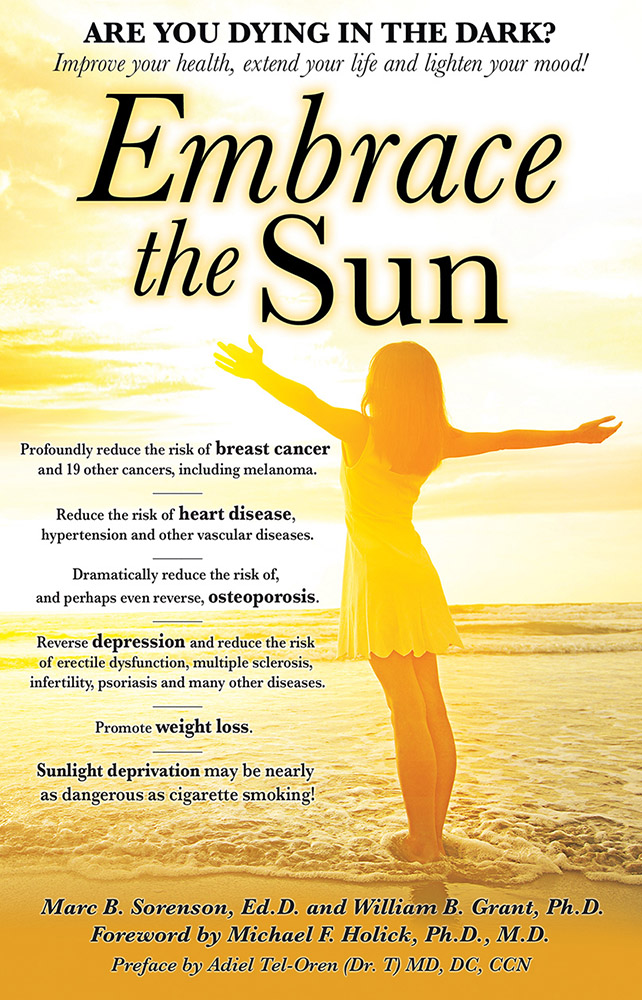 New book, Embrace the Sun, recommends non-burning sun exposure, citing research on sun exposure, vitamin D, and disease risk.
New book, Embrace the Sun, recommends non-burning sun exposure, citing research on sun exposure, vitamin D, and disease risk.
Available on Amazon, Embrace the Sun, by authors Marc B. Sorenson, Ed.D. and William B. Grant, Ph.D., claim that sun avoidance may be nearly as hazardous to your health as cigarette smoking! Will there soon be a Surgeon General’s warning about staying indoors or putting on too much sunscreen? Is this book based on science or pure science fiction?
The book is based on science and research. Together, Sorenson and Grant have worked 62 years studying and practicing health, nutrition, and the proper relationship with sunlight. A mountain of evidence exists showing that sunlight can promote weight loss, reduce depression, and profoundly decrease the risk of today’s common diseases including most cancers, heart disease, autism, diabetes, osteoporosis, multiple sclerosis, infertility, preterm birth and psoriasis. Do I have your attention? This book provides solid evidence towards a case for regular, sensible sun.
“Marc Sorenson and Bill Grant take us on a delightful journey to better understand the health benefits of our magnificent sun at a time when our sun has been demonized by various health organizations, including the dermatology community, which has been essentially unchallenged for the past 50 years,” said Michael F. Holick, Ph.D., M.D., Boston University Medical Center, “Embrace the Sunis an easy read that is chock-full of valuable information about the health benefits of sensible sun exposure. It provides a very practical guide on how to take advantage of our Magnificent Sun.”
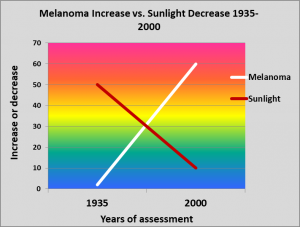 According to the book, 75% of all melanomas occur on areas of the body that are seldom or never exposed to sunlight. Additionally, sun exposure has decreasedby about 90% in the U.S. population since 1935. During that same period, melanoma incidence has increasedexponentially, by approximately 3,000%! This evidence debunks the myth that melanoma is caused primarily by the sun, and instead suggests that the disease is at least partially caused by sun deprivation.
According to the book, 75% of all melanomas occur on areas of the body that are seldom or never exposed to sunlight. Additionally, sun exposure has decreasedby about 90% in the U.S. population since 1935. During that same period, melanoma incidence has increasedexponentially, by approximately 3,000%! This evidence debunks the myth that melanoma is caused primarily by the sun, and instead suggests that the disease is at least partially caused by sun deprivation.
“This book is a tour de force for health effects of exposure to the sun,” said Cedric F. Garland, Dr. Ph. F.A.C.E., University of California at San Diego. “It is written simply enough and in such a light-hearted vein that any intelligent fifth grader can and should read it. It also should be required reading for every upcoming doctor in training and all health care professionals.”
Sorenson and Grant prepare the reader to make an informed choice. With summer coming, is it wise to get out regularly at midday, exercise, and soak up some rays? Or better to stay indoors, continuing the current regimen? Could it be that something so central to nature, the sun, which has been part of the human race for thousands of years is now bad for us? In this blip that is the late 20thand beginning 21stcentury has sun avoidance been helpful or hurtful? Read Embrace the Sun and find out!
About Marc B. Sorenson, Ed. D.
Dr. Sorenson is a doctor of education (EdD) with a health background. He and his wife, Vicki, developed one of the world’s top resorts (National Institute of Fitness). During 20 years, their clients lost over 100 tons of fat; two thirds of diabetic guests were freed of medication in two weeks; and others recovered from cholesterol, arthritis, and myriad additional maladies. Sorenson has written ten books and hundreds of blogs for his site, Sunlight Institute. On the recommendation of Senator Orrin Hatch, a flag was flown over the U.S. Senate building to honor his contributions to world health.
About William B. Grant, Ph.D.
Dr. William Grant is an epidemiologist and founder of the nonprofit organization Sunlight, Nutrition and Health Research Center. Grant holds a PhD in Physics from UC Berkeley and worked as a senior research scientist in the field of optical and atmospheric sciences at SRI International, JPL, and NASA Langley.
He published the first paper linking dietary factors to risk of developing Alzheimer’s disease in 1997. Since 2000, he has focused on ultraviolet-B (UVB) radiation and vitamin D and their relation to cancer and other diseases. He has written over 256 peer-reviewed articles, editorials, and letters to the editor on vitamin D and health.
What do you know about melanoma?
May is Melanoma Awareness Month, Therefore, we will discuss some truths to be aware of:
- First of all, seventy-five percent of these cancers occur on areas of the body that are seldom or never exposed to sunlight.[1] For example, research has shown that melanomas in women occur primarily on the upper legs, and in men more frequently on the back—areas of little sun exposure.
- Most noteworthy, in the U.S., sun exposure has decreased by about 90% since 1935. In the same time, melanoma incidence has increased by 3,000%! [2] [3] [4]
Dr. Diane Godar furnishes this exceptionally important melanoma information:[5]
- The same as in the US, while sun exposure in Europe has profoundly decreased, there has been a spectacular increase in the disease.
- Men who work outdoors have about half the risk as men who work indoors. Hence, sun exposure could not be the cause.
- in addition, outdoor workers, while receiving 3-9 times the sun exposure as indoor workers, have had no increase in melanoma since before 1940, whereas the incidence in indoor workers has increased steadily and exponentially.
- Especially relevant is that sunscreen invention, along with its steadily increasing use, has not reduced the risk of melanoma. Rather, the disease has increased as sunscreen use has increased.
- Increasing melanoma incidence significantly correlates with decreasing personal annual sunlight exposure.
- Also, outdoor workers get many sunburns but still have dramatically lower risk of contracting the disease.
So, since melanoma increases as sun exposure decreases, should we continue to blame the sun?
Here are more facts you should know about the causes of melanoma:
- First of all, people in the highest quintile (fifth) of alcohol consumption have a 65% increase in risk.[6]
- Weekly meat consumption increases the risk of melanoma by 84% and daily fruit consumption reduces the risk by nearly 50%.[7]
- Furthermore, those with the highest levels of blood PCBs have 7-times the risk compared to those with the lowest levels.[8]
- Recent use of Viagra is associated with an 84% increase in risk, and long-term use of the drug is associated with a 92% risk increase.[9]
- Finally, there is a positive association between melanoma and obesity.[10]
Furthermore, Dr. Adele Green found that the strongest risk factor for both limb and trunk melanoma was moles. The presence of more than 10 moles on the arm predicted a 42-times increased risk.[11]
Therefore, please stop blaming the sun. Safely embrace the non-burning sun and reduce your risk of melanoma.
References:
[1] Crombie IK. Distribution of malignant melanoma on the body surface.Br J Cancer. 1981 Jun;43(6):842-9.
[2] Melanoma International Foundation, 2007 Facts about melanoma. Sources: National Cancer Institute 2007 SEER Database, American Cancer Society’s 2007 Facts and Figures, The Skin Cancer Foundation, The American Academy of Dermatology.
[3] Ian D. Wyatt and Daniel E. Hecker. Occupational changes in the 20th century. Monthly Labor Review, 2006 pp 35-57: Office of Occupational Statistics and Employment Projections, Bureau of Labor Statistics.
[4] US Congress, Office of Technology Assessment, Catching Our Breath: Next Steps for Reducing Urban Ozone, OTA-O-412 (Washington, DC: US Government Printing Office, July 1989).
[5] Stephen J Merrill, Samira Ashrafi, Madhan Subramanian & Dianne E Godar. Exponentially increasing incidences of cutaneous malignant melanoma in Europe correlate with low personal annual UV doses and suggests 2 major risk Factors. Dermato-endocrinology 2015;7:1
[6] Millen AE, Tucker MA, Hartge P, Halpern A, Elder DE, Guerry D 4th, Holly EA, Sagebiel RW, Potischman N. Diet and melanoma in a case-control study. Cancer Epidemiol Biomarkers Prev. 2004 Jun;13(6):1042-51.
[7] Gould Rothberg BE, Bulloch KJ, Fine JA, Barnhill RL, Berwick M. Red meat and fruit intake is prognostic among patients with localized cutaneous melanomas more than 1 mm thick. Cancer Epidemiol. 2014 Oct;38(5):599-607.
[8] Gallagher RP, Macarthur AC, Lee TK, Weber JP, Leblanc A, Mark Elwood J, Borugian M, Abanto Z, Spinelli JJ. Plasma levels of polychlorinated biphenyls and risk of cutaneous malignant melanoma: a preliminary study. Int J Cancer. 2011 15;128(8):1872-80.
[9] Li WQ, Qureshi AA, Robinson K, Han J. Sildenafil use and increased risk of incident melanoma in US men: a prospective cohort study. JAMA Intern Med. 2014 Jun;174(6):964-70C
[10] Karimi K, Lindgren TH, Koch CA, Brodell RT. Obesity as a risk factor for malignant melanoma and non-melanoma skin cancer. Rev Endocr Metab Disord. 2016 Sep;17(3):389-403.
[11] Green AC, Siskind V. Risk factors for limb melanomas compared with trunk melanomas in Queensland. Melanoma Res. 2012 ;22(1):86-91.
What is Alzheimer’s disease?
By Marc Sorenson, EdD, Sunlight Institute
Alzheimer’s disease is a plague in our modern world. It is a progressive mental deterioration that can occur in middle or old age, due to degeneration of the brain. Alzheimer’s is also the most common cause of premature senility. The United States will see a 44 percent increase in individuals with Alzheimer’s disease by 2025.[1] First of all, the disease occurs because amyloid plaques appear in brain tissue. These plaques consist of tangles of amyloid protein (a complex protein resembling starch) in nervous tissue. They are pathological markers of the disease that are found in spaces between the brain’s nerve cells. As a result of these plaques, the brain loses its ability to function properly.
Our experience with Alzheimer’s sufferers
My wife, Vicki, and I worked with residents of an assisted-care facility for over three years. We conducted and supervised church meetings for many disabled, elderly people. Because we worked up close and personally with these residents, we understood the devastating effects of Alzheimer’s. Many of these residents could not find their way to the church meeting room without our assistance. Therefore, they obviously had the disease. Additionally, it was manifest because many of them were unable to recognize us after our being away for a day. Also, they were prone to simply get up and leave the building and be found (if lucky) wandering outside.
Does sun exposure help to reduce Alzheimer’s?
First of all, research indicates that vitamin D and omega 3 fatty acids may help in removing the aforementioned plaques.[2] Therefore, they reduce the risk or severity of AD. So, the disease may be lessened by sun exposure, since 90% of vitamin D produced in the US population is due to sun exposure.[3]
Hence, it is no surprise that the latest research paper found high risk in low-sunlight countries. Consequently, the researchers stated: “According to sunlight data, we can conclude that countries with low average sunlight have high AD (Alzheimer’s disease) death rate.[4]”
Are there other indications that sun exposure is associate to reduced risk?
Sun exposure directly correlates to non-melanoma skin cancer (NMSC). Therefore, the latter is often used as a sun-exposure indicator. It is thus compared with various diseases to evaluate the relationship between them and sun exposure. A 2013 article, published in the journal Neurology, reveals that among people with NMSC, the risk of Alzheimer’s disease (AD) is profoundly decreased:[5] Those with NMSC had a 79% reduction in disease risk. Stated another way, those without NMSC had about five times the risk of Alzheimer’s! Of course, this demonstrates the importance of sun exposure in reducing the risk, whether due to vitamin D production of from other photoproducts of the sun.
So, what is the bottom line? Be sure to obtain some unscreened, non-burning sun exposure and keep your marbles!
[1] Disease growth: U.S. will see average 44 percent increase in Alzheimer’s disease by 2025. Alzheimer’s Association 2015. https://www.alz.org/alzwa/documents/alzwa_resource_ad_fs_ad_state_growth_stats.pdf
[2] Champeau R. Vitamin D, omega-3 help clear amyloid plaques found in Alzheimer’s. UCLA Newsroom 2013.
[3] Reichrath J. The challenge resulting from positive and negative effects of sun: how much solar UV exposure is appropriate to balance between risks of vitamin D deficiency and skin cancer? Prog Biophys Mol Biol 2006;92(1):9-16
[4] Câmara AB, de Souza ID, Dalmolin RJS. Sunlight Incidence, Vitamin D Deficiency, and Alzheimer’s Disease. J Med Food. 2018 Mar 22 [Epub ahead of print].
[5] White RS, Lipton RB, Hall CB, Steinerman JR. Nonmelanoma skin cancer is associated with reduced Alzheimer disease risk. Neurology. 2013 21;80(21):1966-72.
MS prevention by sunlight. By Marc Sorenson, Ed.D. Sunlight Institute
What is MS?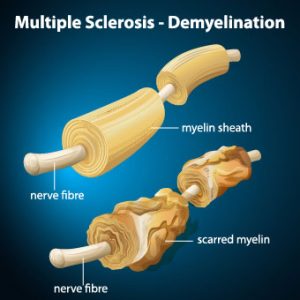
MS is a painful, debilitating, crippling, disease in which immune cells initiate an inflammatory response against myelin. Myelin is the nerves’ protective cover. It is rather like an electric wire that has lost its rubber cover. So, this process, known as demyelination, leaves the nerves bare and susceptible to “short circuiting.” From 85 to 170 people per 100,000 in the USA suffer from MS, and the rate among women, during the period from 1991 through 1994, has increased by 50% compared to the period from 1982 through 1986. Also, as of 2010, the last year for which we could find statistics, there were 350,000-400,000 cases diagnosed in the USA.
There is no doubt that sunshine reduces the risk of MS, because The risk of multiple sclerosis in far northern areas, where there is little sunshine, is more than 100 times greater than it is in equatorial areas. So, in those areas, where sunlight is intense, due to directness of the sun, the rate of MS approaches zero. [1], [2], [3]
And do you know anyone who suffers from multiple sclerosis? They should probably read this blog and then obtain plenty of non-burning sun exposure.
The latest Research on MS, sun exposure and vitamin D.
A study carried out in Southern California corroborates the sun exposure benefits to MS reduction.[4] First of all, the researchers recruited members of three different ethnicities (blacks, Hispanics and whites). In addition, they further divided those ethnicities into those who suffered from MS (known as cases) and those who were free from the disease (controls). They then simultaneously examined lifetime sun exposure and blood vitamin D levels, accounting for genetic ancestry and other factors. The results were impressive:
- Among blacks, the highest lifetime sun exposure was associated with a 47% lower risk, independently of blood levels of vitamin D.
- Among whites, the highest lifetime sun exposure was associated with a 32% lower risk. In this group, highest vitamin D levels also associated with a lower risk of MS.
- Among Hispanics, the highest lifetime sun exposure was associated with a 34% lower risk, independently of blood levels of vitamin D.
This is just the latest research to determine that sun exposure lessened the risk of MS independently of vitamin D. In addition, researchers used animals with experimental autoimmune encephalomyelitis (EAE) (an experimental form of MS). It was induced in animals in a lab setting and then used to determine the relative influences of UVR and vitamin D on MS. In conclusion, they stated, “These results suggest UVR [sun] is likely suppressing disease independent of vitamin D production. Thus, vitamin D supplementation alone may not replace the ability of sun (UV) to reduce MS susceptibility.”[5]
More on sunlight and MS from the same researchers
Later on, some of these same researchers investigated the mechanism by which sun exposure suppressed the disease and determined that UV light selectively inhibits spinal cord inflammation and demyelination.[6]
Furthermore, in another study, scientists performed an investigation with UVR. UVR is the same radiation emitted by the sun and sunbeds or sunlamps. It was administered to animals with EAE.[7] First of all, the researchers found that UVR treatments stopped inflammation and demyelination of the spinal cord. It did so by inhibiting a chemical known as a chemokine, also known as a cytokine. Cytokines are specialized proteins that are either inflammatory or anti-inflammatory in their nature. Therefore, inflammatory cytokines or chemokines are the cause of inflammation and autoimmune attacks resulting in MS. In addition, UVR directly initiated the MS-ameliorating effects, independent of vitamin D.
To conclude:
Finally, as wonderful as vitamin D is, we should realize this: The production of vitamin D is only one of the profoundly healthful effects that are due to Sun Exposure. Hence, those who take vitamin D and believe they will derive all the benefits of sun exposure, are wrong. Consequently, they could be “dead wrong” in the case of a scourge like MS. So, be sure to obtain your full share of non-burning sunlight whenever possible. It could save your life. And, it could save the lives of those who have the disorder or who might be susceptible to it. Maybe we should start paying more attention to our sun exposure?
This is one of many blogs that I and others have written on this subject. In addition, here are a few more that may interest you:
http://sunlightinstitute.org/research-shows-sun-exposure-thwarts-multiple-sclerosis-ms/
http://sunlightinstitute.org/a-vitally-important-study-on-sunlight-and-multiple-sclerosis-ms/
Embrace the sun! Without burning, of course
[1] Alter M, Yamoor M, Harshe M. Multiple sclerosis and nutrition. Arch Neurol l974;31:267-72.
[2] Kurtkze, J. Geography in multiple sclerosis. J Neurol 1977;215:1-26.
[3] Hayes CE, Cantorna MT, DeLuca HF.Vitamin D and multiple sclerosis. Proc Soc Exp Biol Med 1997;216:21-27
[4] Langer-Gould A, Lucas R, Xiang AH, Chen LH, Wu J, Gonzalez E, Haraszti S, Smith JB, Quach H, Barcellos LF. Nutrients. 2018 Feb 27;10(3).
[5] Becklund BR, Severson KS, Vang SV, DeLuca HF. UV radiation suppresses experimental autoimmune encephalomyelitis independent of vitamin D production. Proc Natl Acad Sci U S A. 2010;107:6418-23.
[6] Wang Y, Marling SJ, Beaver EF, Severson KS, Deluca HF. UV light selectively inhibits spinal cord inflammation and demyelination in experimental autoimmune encephalomyelitis. Arch Biochem Biophys. 2015 1;567:75-82
[7] Wang Y, Marling SJ, Beaver EF, Severson KS, Deluca HF. UV light selectively inhibits spinal cord inflammation and demyelination in experimental autoimmune encephalomyelitis. Arch Biochem Biophys. 2015 1;567:75-82.
Marc Sorenson, EdD, for breast cancer prevention. 
While many doctors know that ultraviolet radiation (UVR) from sunlight reduces risk of breast cancer, they have missed something. UVR stimulates production of vitamin D in human skin. Therefore, many health professionals assume that vitamin D is responsible for the reduced cancer risk. This may lead them to advocate the use of vitamin D supplementation and totally miss the bigger picture. In addition to vitamin D, UVR from sunlight or sunlamps produces many supplementary healthful photoproducts. Among others, nitric oxide, serotonin, endorphin and BDNF are produced by sunlight, and these photoproducts are vital to health. And, it is likely that these healthful photoproducts lead to an inhibition of breast cancer.
New research shows that sun exposure per se is capable of reducing the risk of breast cancer.
Consequently, it should not surprise us that for breast cancer, sunlight’s effects go beyond vitamin D.[1] Researchers at Children’s Hospital Oakland Research Institute, used a murine model (mice) that easily develops breast cancer, and treated them with UVR. Much as we might expect, they found that UVR treatments produced significant anti-cancer effects. Furthermore, they found that neither dietary vitamin D nor topical vitamin D influenced cancer risk. Because of their findings, they stated the following: “UVR’s inhibitory effects occur irrespective of whether or not the treatment increases circulating D3 in the mice.” Also, they made one more important comment regarding their research on breast cancer and UVR. “Therefore, supplemental D3 may not mimic all possible beneficial effects of UVR, and uncovering non-D3-mediated mechanisms of UVR tumor inhibition may lead to novel strategies for cancer prevention.”
An important point about vitamin D, sunlight and breast cancer.
Finally, there is no doubt that vitamin D has anticancer benefits. This research however, is especially relevant in that it corroborates what I have said in my soon-to-be-released book, Embrace the Sun. First of all, we must not put all of the benefits of sunlight in the vitamin D box. Secondly, sun exposure performs myriad miracles beyond vitamin D. One of those miracles may be breast cancer prevention and inhibition. Thirdly, if we erroneously believe that we can obtain all of the sun’s benefits from popping a vitamin D pill, we may miss the holistic effects of the sun, which provide a cornucopia of salubrious results.
So, safely (without burning) embrace the sun and ease your mind about breast cancer.
[1] Anastasia M. Makarova, Flora Frascari, Parastoo Davari, Farzam Gorouhi, Philip Dutt, Lynn Wang, Akash Dhawan, Grace Wang, Jeffrey E. Green, Ervin H. Epstein, Jr. Ultraviolet radiation inhibits mammary carcinogenesis in an ER negative murine model by a mechanism independent of vitamin D3. Downloaded from cancerpreventionresearch.aacrjournals.org on April 12, 2018.
Marc Sorenson, EdD
What is IBD?
First of all, IBD consists of two primary diseases, ulcerative colitis (UC)  and Crohn’s disease (CD). UC is a chronic inflammatory condition characterized by relapsing and remitting episodes of inflammation limited to the mucosal layer of the colon.[1] Crohn’s disease, however, can involve any part of the gastrointestinal tract from the mouth to the anus. Yet, it most commonly affects the small intestine or the colon, or both.[2]
and Crohn’s disease (CD). UC is a chronic inflammatory condition characterized by relapsing and remitting episodes of inflammation limited to the mucosal layer of the colon.[1] Crohn’s disease, however, can involve any part of the gastrointestinal tract from the mouth to the anus. Yet, it most commonly affects the small intestine or the colon, or both.[2]
The gift of sunlight
First of all, there is a beautiful gift that may prevent or lessen IBD. The gift, (sunlight) awaits us, but if we do not accept the gift, we are no better off than if we didn’t have it. So it is in Italy, where those who suffer from IBD are shown to have far less sun exposure than those who do not have the disease.[3] Therefore, this may indicate that part of the cause of IBD is lack of sunlight. And in Italy, low sun exposure probably indicates a reluctance to step outside because, Italy is a sunny country. Maybe, many of the Italians who succumb to IBD, have obviously not accepted the gift. Either that, or they are using too much sunscreen, since sunscreen blocks the sun.
Furthermore, IBD patients are at an increased risk for fractures. Hence, one may conclude that both maladies may be due to low sun exposure.
Embrace the sun to prevent IBD
Another investigation, conducted over 12 years and involving hundreds of thousands of IBD patients produced remarkable outcomes. Hospitalizations for both UC and CD were far higher among those with low sun exposure.[4] And, the same relationship was shown between sun exposure, bowel surgeries and deaths: more surgeries were needed for those patients who experienced the lowest sun exposure. Also, more deaths occurred among those with low exposure.
And what about non-IBD patients?
Another side note to this investigation was the large number of non-IBD patients analyzed for sun exposure levels. It is most noteworthy that the same relationship existed as with the IBD patients. Low sun exposure associated with prolonged hospitalizations and more deaths when compared with high exposure. Especially relevant is other research involving the association of Crohn’s disease to surgery. It found that surgery for the disease was significantly reduced among patients who received more sun exposure.[5]
The north-south gradient
In addition, research shows that in the US, there is a north-south gradient for IBD risk.[6], [7], [8], [9] The risk of developing the disease is significantly lower in southern latitudes (because sun exposure is greater).
An important nutritional note about IBD:
In addition to what we have heretofore described, it is especially relevant to understand that IBD causes malabsorption of nutrients in the gut. Consequently, it leads to diseases of malnutrition.[10] And, vitamin D is one of the “nutrients” that may not be absorbed efficiently. Therefore, sun exposure (or sunlamps) may be the only viable source of vitamin D for a person with IBD.
Most of all, remember that non-burning sun exposure is essential to human health. It seems like a good idea to obtain your share, and protect your gut from IBD.
[1] Peppercorn M, Cheifetz, A, Rutgeerts P, Grover S. Definition, epidemiology, and risk factors in inflammatory bowel disease. http://www.uptodate.com/contents/definition-epidemiology-and-risk-factors-in-inflammatory-bowel-disease.
[2] Web MD http://www.webmd.com/ibd-crohns-disease/crohns-disease/inflammatory-bowel-syndrome.
[3] Vernia P, Burrelli Scotti G, Dei Giudici A, Chiappini A, Cannizzaro S, Afferri MT, de Carolis A. Inadequate sunlight exposure in patients with inflammatory bowel disease. J Dig Dis. 2018 Jan;19(1):8-14
[4] Limketkai BN, Bayless TM, Brant SR, Hutfless SM. Lower regional and temporal ultraviolet exposure is associated with increased rates and severity of inflammatory bowel disease hospitalization. Aliment Pharmacol Ther. 2014 Sep;40(5):508-17.
[5] Govani SM, Higgins PD, Stidham RW, Montain SJ, Waljee AK. Increased ultraviolet light exposure is associated with reduced risk of inpatient surgery among patients with Crohn’s disease. J Crohns Colitis. 2015 ;9(1):77-81
[6] Schultz M, Butt AG. Is the north to south gradient in inflammatory bowel disease a global phenomenon? Expert Rev Gastroenterol Hepatol. 2012 Aug;6(4):445-7.
[7] Kappelman MD, Rifas-Shiman SL, Kleinman K, Ollendorf D, Bousvaros A, Grand RJ, Finkelstein JA. The prevalence and geographic distribution of Crohn’s disease and ulcerative colitis in the United States. Clin Gastroenterol Hepatol. 2007 Dec;5(12):1424-9.
[8] Sonnenberg A. Similar geographic variations of mortality and hospitalization associated with IBD and Clostridium difficile colitis. Inflamm Bowel Dis. 2010 Mar;16(3):487-93.
[9] Holmes EA, Xiang F, Lucas RM. Variation in incidence of pediatric Crohn’s disease in relation to latitude and ambient ultraviolet radiation: a systematic review and analysis. Inflamm Bowel Dis. 2015 ;21(4):809-17
[10] Margulies SL, Kurian D, Elliott MS, Han Z. Vitamin D deficiency in patients with intestinal malabsorption syndromes–think in and outside the gut. J Dig Dis. 2015 Nov;16(11):617-33.
Health benefits of UV by Marc Sorenson, Ed.D.
How important is UV?  A transcendentally important scientific paper, by Dr. AT Slominski and colleagues, has added significant information about UV (sunlight) for skin. In addition, it explains the intricate connection between sunlight and the immune, endocrine and central nervous systems.[1] The name of the research paper, published in the journal Endocrinology, is How ultraviolet light touches the brain and endocrine system through skin, and why. The authors begin the abstract by stating that “the skin is a self-regulating protective barrier organ that is empowered with sensory and computing capabilities to counteract the environmental stressors to maintain/restore disrupted cutaneous homeostasis.” In other words, the skin has the ability to take on what life deals it and maintain its equilibrium and balance. In addition, the skin communicates bidirectionally with the central nervous, endocrine and immune systems. Thus, it helps to maintain balance for all body systems.
A transcendentally important scientific paper, by Dr. AT Slominski and colleagues, has added significant information about UV (sunlight) for skin. In addition, it explains the intricate connection between sunlight and the immune, endocrine and central nervous systems.[1] The name of the research paper, published in the journal Endocrinology, is How ultraviolet light touches the brain and endocrine system through skin, and why. The authors begin the abstract by stating that “the skin is a self-regulating protective barrier organ that is empowered with sensory and computing capabilities to counteract the environmental stressors to maintain/restore disrupted cutaneous homeostasis.” In other words, the skin has the ability to take on what life deals it and maintain its equilibrium and balance. In addition, the skin communicates bidirectionally with the central nervous, endocrine and immune systems. Thus, it helps to maintain balance for all body systems.
How does UV work?
First of all, ultraviolet energy (UV and UVB light) triggers all of these marvelous processes. UV, of course is available from sunlight, sunbeds or sunlamps. Its electromagnetic energy, through the skin, converts to chemical, hormonal and neural signals. These signals promote positive effects on the immune system, the endocrine system and the brain. Furthermore, endorphins (opioid-like substances) are increased and immune-system proteins are mobilized; consequently, health improves with UV. And, sun exposure regulates the endocrine system, by way of exposure to the skin, to produce or diminish hormones as needed. Especially relevant is that these effects take place independently of vitamin D synthesis.
Health increases with UV due to the magnificent sun, and our magnificent skin. As a result of the above information, it seems like it would be a good idea to soak up some non-burning sun each day when available. And, when it is not, we should find another UV source. In our soon-to-be-published book, Embrace the Sun, we discuss many facts about the healthful effects sun exposure:
A few healthful effects of sun (UV) exposure
- prevents and reverses obesity
- Improves longevity by reducing the risk of death by 50% over 20 years
- reduces the risk of hip fracture by 90% when compared to sun avoidance
- prevents the risk of breast cancer by 90% when compared to sun avoidance
- reduces by 50% the risk of melanoma in outdoor workers compared with indoor workers
- increases heart and vascular strength
- dramatically improves mood
- reduces the risk of multiple sclerosis
- reduces risk of most internal cancers
- cures psoriasis and eczema
- reduces risk of nervous system disorders
- prevents memory loss
- prevents myopia
The above list is not surprising in view of this new research, nor is the list complete. UV has many more healthful effects, which I’m sure the authors of this research acknowledge. Hence, the scientists sum up their research in this manner: “Thus, UV touches the brain and central neuroendocrine system to reset body homeostasis. This invites multiple therapeutic applications of UV radiation, for example in the management of autoimmune and mood disorders, addiction, and obesity.”
In conclusion, this seem like more compelling evidence to safely embrace the sun, no?
[1] Slominski AT, Zmijewski MA, Plonka PM, Szaflarski JP, Paus R. How ultraviolet light touches the brain and endocrine system through skin, and why. Endocrinology. 2018 Mar 12. [Epub ahead of print]
The superbugs are among us. Should we return to the use of sanatoria?
By Marc Sorenson, EdD
First of all, one should know that sanatoria are secluded hospitals. In addition, they usually specialize in healing through good food, fresh air and sunlight. Some scientists are now suggesting that we reestablish the use of sanatoria for healing.[1] They feel that sanatoria may be just the answer we seek for the prevention and healing of infectious diseases.
Interestingly, sanatoria were used effectively in the early 20th century (before antibiotics) and were really large outdoor solariums (sunrooms). These facilities allowed patients to be in natural surroundings, and in some cases, to expose themselves to direct sunlight. To demonstrate the efficacy of these facilities in curing tuberculosis (TB), consider the following history of Dr. Aguste Rollier:
Should we use sanatoria for healing TB?
First of all, records of 1,129 TB cases showed solariums cured 87% of “closed cases” and 76% of “open cases. “Among 158 patients with tuberculosis of the hip, 125 were cured and 102 “regained complete recovery of articular function.”[2] Dr. Rollier also had other successes. “During a time just following World War I, 1,746 of 2,167 tubercular patients under his care completely recovered. Furthermore, the only failures were among those who had allowed their tuberculosis to enter its most advanced stages.”[3]
Superbugs arrive from Peru.
In 2009, the first case of drug-resistant TB arrived in the US from Peru.[4] It was nearly 100% resistant to antibiotics. Consequently, it could cause an immense killer epidemic with the return of TB. There seems to be no answer to the “superbug” causing it. Or is there an answer? Could the sun provide a solution to this health threat? The superbugs are upon us like a bad horror movie. When they start to take over the earth, there will be few cures. But, UV light from the sun, or sun lamps, are remedies that still exist. Therefore, we would be well-advised to have our defenses set up in advance by enjoying daily sun exposure.
Another more recent historical perspective regarding sanatoria and sun exposure.
I recently happened across research that should be of interest to those who love the Sun. It gave a historical perspective of TB in the city of Bern, Switzerland. In addition, it showed how Bern wiped out most of its TB problems. Especially relevant is the fact that the city used lifestyle changes, not drugs. And, those changes included greater access to sun exposure.[5] The authors studied TB incidence during the period from 1856-1950. There were three areas of the city assessed for their historical TB problems. One was known as the Black Quarter, where during 1911-1915 there were 550 cases of TB per 100,000 people. The second was the City Center with 327 cases per 100,000 people. The third area was the Outskirts, with 209 cases per 100,000 people. There were three living conditions correlating closely to TB:
- The number of persons per room. A higher number predicted a greater risk of TB.
- A greater number of rooms without sunlight predicted a greater risk of TB.
- A greater number of windows per apartment predicted a diminished risk of TB
Consequently, the country worked to address these problems by reducing room crowding, providing open-air schools and building sanatoria. As a result, TB risk dropped from 330 cases per 100,000 in 1856 to 33 per 100,000 in 1950—a 90% drop! Also, I expect that health care cost dramatically decreased.
With the superbugs gaining strength each year, maybe we should reestablish the use of sanatoria?
Another thought: sun exposure probably works as well with many other diseases as it does with TB. Hence, the day may come when sanatoria, especially solariums, may be the only choice for curing infections. Finally, why not sunbathe daily in a non-burning fashion? In addition, sunlamps (in the absence of sunny days) could be valuable to the the health, because they also produce some of the same types of healing light (UVB and UBA) as the sun. Safely and regularly embrace the sun to protect your health!
[1] Greenhalgh I, Butler AR. Sanatoria revisited. Sunlight and health. J R Coll Physicians Edinb. 2017;47(3):276-280.
[2] Clark, W. Treatment of Bone and joint tuberculosis with Tuberculin and Heliotherapy. Journal of Bone and Joint Surgery 1923;5:721-39.
[3] Fielder, J. Heliotherapy: the principles & practice of sunbathing. Soil and Health Library (online) http://www.soilandhealth.org/index.html
[4] http://www.sphere.com/nation/article/first-case-of-highly-drug-resistant-tuberculosis-in-US/19294836?icid=main|htmlws-main-n|dl1|link3|http%3A%2F%2Fwww.sphere.com%2Fnation%2Farticle%2Ffirst-case-of-highly-drug-resistant-tuberculosis-in-US%2F19294836
[5] Zürcher K, Ballif M, Zwahlen M, Rieder HL, Egger M, Fenner L. Tuberculosis Mortality and Living Conditions in Bern, Switzerland, 1856-1950. PLoS One. 2016 16;11(2):e0149195
Obesity: Do vitamin D and sunlight have a part? A new study shows that when vitamin D-deficient pregnant women bear children, the children may become obese.[1] Furthermore, the children had larger waistlines at age 6, compared with children born to women who had sufficient vitamin D levels. The body-fat percentage of those born to vitamin D- deficient women was also significantly higher. Body fat-percentage is a measure of obesity (or lack thereof).
when vitamin D-deficient pregnant women bear children, the children may become obese.[1] Furthermore, the children had larger waistlines at age 6, compared with children born to women who had sufficient vitamin D levels. The body-fat percentage of those born to vitamin D- deficient women was also significantly higher. Body fat-percentage is a measure of obesity (or lack thereof).
The authors stated that 95% of vitamin D production in the body comes from sun exposure to skin. That is correct. Consequently, the expectant mothers spend too much time indoors. Or, they are frightened into sunscreen use, which can prevent production of 99% of vitamin D by sun exposure. Therefore, this type of obesity is a sun-deprivation disease. The research suggested that vitamin D supplements might be the answer. However, the answer is not supplements when sunlight is available. We should promote safe, non-burning sun exposure to prevent obesity.
Much has been researched lately regarding the importance of sunlight in preventing obesity. In my last blog, I mentioned several of these studies: http://sunlightinstitute.org/staying-slim-sunlight/
Here is a list of the methods by which sun exposure helps to prevent or reverse obesity:
- First of all, because blue-spectrum light causes cells to dump part of their fat load, it helps weight-control
- Secondly, early-morning light, because it resets circadian rhythms, reduces the risk of weight-gain.
- Thirdly, exposure to ultraviolet radiation (one of the spectrums in sun exposure) has been shown to impressively reduce weight gain in mice on a high-fat diet. Especially relevant is the fact that vitamin D levels made no difference in the weight of the animals.
In conclusion, non-burning sun exposure is vitally important to human health. If you would like to have a fat content that is less than others, be sure to obtain your share or sunshine and make weight-control for you and your children much easier!
[1] V. Daraki, T. Roumeliotaki, G. Chalkiadaki, M. Katrinaki, M. Karachaliou , V. Leventakou, M. Vafeiadi, K. Sarri, M. Vassilaki, S. Papavasiliou, M. Kogevinas and L. Chatzi. Low maternal vitamin D status in pregnancy increases the risk of childhood obesity. Pediatric Obesity Pediatr Obes. 2018 Jan 28. doi: 10.1111/ijpo.12267. [Epub ahead of print]
Obesity: Do vitamin D and sunlight have a part? A new study shows that when vitamin D deficient pregnant women bear children, the children may become obese.[1] Furthermore, the children had larger waistlines at age 6, compared with children born to women who had sufficient vitamin D levels. The body-fat percentage of those born to vitamin D- deficient women was also significantly higher. Body fat-percentage is a measure of obesity (or lack thereof).
How is vitamin D produced?
The authors stated that 95% of vitamin D production in the body comes from sun exposure to skin. That is correct. Consequently, the expectant mothers spend too much time indoors. Or, they are frightened into sunscreen use, which can prevent production of 99% of vitamin D by sun exposure. Therefore, this type of obesity is a sun-deprivation disease. The research suggested that vitamin D supplements might be the answer. However, the answer is not supplements when sunlight is available. We should promote safe, non-burning sun exposure to prevent obesity.
Are there other studies regarding sunlight and obesity?
Much has been researched lately regarding the importance of sunlight in preventing obesity. In my last blog, I mentioned several of these studies: http://sunlightinstitute.org/staying-slim-sunlight/
Here is a list of the methods by which sun exposure helps to prevent or reverse obesity:
- First of all, because blue-spectrum light causes cells to dump part of their fat load, it helps weight-control
- Secondly, early-morning light, because it resets circadian rhythms, reduces the risk of weight-gain.
- Thirdly, exposure to ultraviolet radiation (one of the spectrums in sun exposure) has been shown to impressively reduce weight gain in mice on a high-fat diet. Especially relevant is the fact that vitamin D levels made no difference in the weight of the animals.
In conclusion, non-burning sun exposure is vitally important to human health. If you would like to have a fat content that is less than others, be sure to obtain your share or sunshine and make weight-control for you and your children much easier!
[1] V. Daraki, T. Roumeliotaki, G. Chalkiadaki, M. Katrinaki, M. Karachaliou , V. Leventakou, M. Vafeiadi, K. Sarri, M. Vassilaki, S. Papavasiliou, M. Kogevinas and L. Chatzi. Low maternal vitamin D status in pregnancy increases the risk of childhood obesity. Pediatric Obesity Pediatr Obes. 2018 Jan 28. doi: 10.1111/ijpo.12267. [Epub ahead of print]

